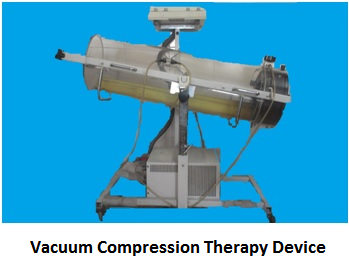Vacuum Compression Therapy: Difference between revisions
No edit summary |
(Undo revision 90292 by Sheik Abdul Khadir (talk)) |
||
| Line 1: | Line 1: | ||
<div class="editorbox"> | <div class="editorbox"> | ||
'''Original Editor '''- [[User:Sheik Abdul Khadir|Sheik Abdul Khadir]] | |||
'''Top Contributors''' - {{Special:Contributors/{{FULLPAGENAME}}}} <br> | |||
</div> | </div> | ||
== Introduction == | |||
<div>In 1956, Erler and Itting designed a vacuum-compression unit that served as the prototype for the clinical model in use today. The device consists of a plexiglass chamber connected to a compressor. The unit provides a timed alteration of positive and negative pressures at a selectable range of intensities. Researchers believe that VCT systems do improve total tissue blood flow and oxygenation. < | <div>In 1956, Erler and Itting designed a vacuum-compression unit that served as the prototype for the clinical model in use today. The device consists of a plexiglass chamber connected to a compressor. The unit provides a timed alteration of positive and negative pressures at a selectable range of intensities. Researchers believe that VCT systems do improve total tissue blood flow and oxygenation. <ref name="akbari">Akbari et al ; Effects of vacuum compression therapy on healing of diabetic foot ulcers :Randomized control trial ;JRRD; Vol 44; No 5;2007; 631-636.</ref><br></div><div><br></div> | ||
== Device == | |||
<div> | <div> [[Image:VCT-1.png]]</div><div></div><div>The device comprises of </div> | ||
#Vacuum chamber | |||
#Pressure Monitor | |||
#Rubber cuff | |||
#Compressor Unit. | |||
<br> | |||
== Mechanism of Action == | |||
< | == References == | ||
<references />. <br> | |||
Revision as of 13:10, 17 March 2014
Original Editor - Sheik Abdul Khadir
Top Contributors - Sheik Abdul Khadir, WikiSysop, Kim Jackson and Lucinda hampton
Introduction[edit | edit source]
Device [edit | edit source]
- Vacuum chamber
- Pressure Monitor
- Rubber cuff
- Compressor Unit.
Mechanism of Action[edit | edit source]
References[edit | edit source]
- ↑ Akbari et al ; Effects of vacuum compression therapy on healing of diabetic foot ulcers :Randomized control trial ;JRRD; Vol 44; No 5;2007; 631-636.
.







